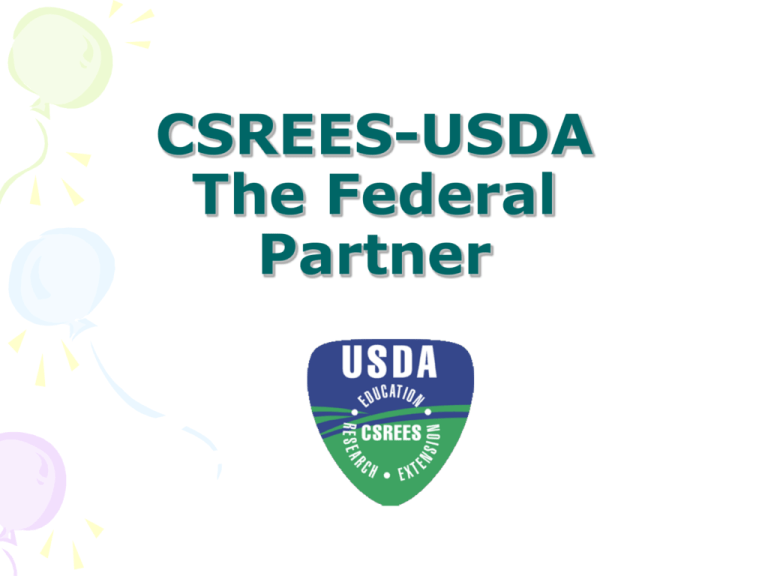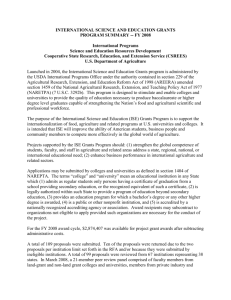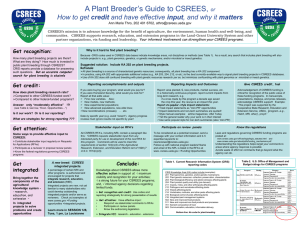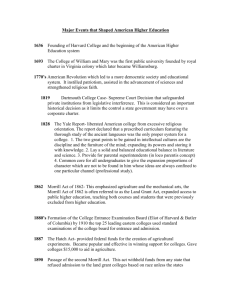CSREES-USDA The Federal Partner
advertisement

CSREES-USDA The Federal Partner The History of the Land-Grant System & the Partnership George Cooper Deputy Administrator Science Education Resource Development What it means to be Land Grant A Legislative Overview Background Materials Prepared for New Directors Conference December 10, 2002 Washington, DC Developed by George Cooper, USDA/CSREES/SERD Key Legislation • Creation of the U.S. Department of Agriculture - May 15, 1862. • First Morrill Act of 1862. • Emancipation Proclamation put into effect January 1, 1863. • Hatch Act of 1887. • Second Morrill Act of 1890. • Smith-Lever Act of 1914. • P.L. 89-106. • Food and Agriculture Act of 1977. • P.L. 95-113 – Section 1444 – Section 1445 Key Legislation, contd. • Equity in Educational Land-Grant Status Act of 1994 • District of Columbia Public Postsecondary Education Reorganization Act of 1974 Creation of the U.S. Department of Agriculture • May 15, 1862. • ..to acquire and to diffuse among the people of the United States useful information on subjects connected with agriculture in the most general and comprehensive sense.. To procure, propagate, and distribute among the people new and valuable seeds and plants... Creation of USDA, contd. • … to acquire and preserve all information concerning agriculture..books and correspondence, practical and scientific experiment, by collection of statistics; and other appropriate means…and distribute them among agriculturists. • USDA Assumes duties previously conducted by the Patent Office. • Department elevated to Cabinet status in 1889 USDA’s Primary Link to LandGrant Institutions The Cooperative State Research, Education, and Extension Service (CSREES) Legislative Overview First Morrill Act of 1862 • Introduced, December 14, 1857; and became law, July 2, 1862. • Donate public lands to States & Territories which may provide colleges for the benefit of agriculture and the mechanic arts. • 20,000 acres for each Senator and Representative in Congress, and 60,000 acres to each Territory. Morrill Act of 1862, contd. • ..lands or script could be sold and the proceeds used for the endowment, support and maintenance of at least one college where the leading object shall be, without excluding other scientific or classical studies, to teach such branches as are related to agricultural and mechanic arts, in such manner as the legislatures of the States and Territories may respectively prescribe in order to promote liberal and practical education of the industrial classes… Morrill Act of 1862, contd. • … funds shall not be applied directly or indirectly, to the purchase, erection, preservation or repair of any building(s). • Annual reports were to be submitted. Emancipation Proclamation • January 1, 1863. • Freed all slaves in the southern states that had seceded from the Union (AR, TX, LA, MS, AL, FL, GA, SC, NC, VA ). Hatch Act of 1887 • March 2, 1887. • Established Agricultural Experiment Stations in connection with the colleges established in the several states under the Morrill Act of 1862, and the acts supplementary thereto. Hatch Act, contd. • To conduct original research or verify experiments on the physiology and diseases of plants and animals; chemical composition of plants; the comparative advantages of rotative cropping; the value of grasses and forage plants; the composition and digestibility of different kinds of food for domestic animals; the scientific and economic questions…. Hatch Act, contd. • and other research bearing directly or indirectly on the agricultural industry of the United States as may in each case be deemed advisable, having due regard to the varying conditions and needs of the respective States and Territories. • Appropriated Federal funds from the Treasury for this purpose from the sale of public lands. Second Morrill Act • August 30, 1890. • To apply a portion of the proceeds of public lands to the more complete endowment and support of the colleges for the benefit of agriculture and mechanic arts established under the provisions of an act of July 2, 1862…. Annually appropriated, out of any money in the Treasury not otherwise appropriated from the sale of public lands….. Second Morrill Act, contd. • Applied only to instruction in agriculture, the mechanic arts, the English language and the various branches of mathematical, physical, natural, and economic science, with special reference to their applications in the industries of life, and to the facilities for such instruction. • Provided………………... Second Morrill Act, contd. • …that no money shall be paid out under this act to any State or Territory for the support and maintenance of a college where a distinction of race or color is made in the admission of students, but the establishment and maintenance of such colleges separately for white and colored students shall be held to be a compliance with the provisions of this act if the funds received be equitably divided... Smith-Lever Act • May 8, 1914. • To provide for cooperative agricultural extension work between the agricultural colleges in the several states receiving the benefits of an Act of Congress approved July 2, 1862, and of the Acts supplementary thereto, and the United States Department of Agriculture. Smith-Lever Act, contd. • .. to aid in diffusing among the people of the United States useful and practical information on subjects relating to agriculture and home economics, and to encourage the application of the same.. Provided, that in any State in which two or more such colleges have been or hereafter may be established the appropriations hereinafter made to such state shall be administered by such college or colleges as the legislature of such State may direct…. Smith-Lever Act, contd. • … work shall consist of giving of instruction and practical demonstrations.., to persons not attending or resident in said colleges…, and imparting to such persons …, through field demonstrations, publications, and otherwise….. P.L. 89-106 • August 4, 1965. Funds to 1890’s in 1967. • ..Appropriations of USDA may be expended for the erection of buildings and other structures on land owned by States, counties, municipalities… • Secretary is authorized to make grants to State agricultural experiment stations, colleges, universities, and other research institutions and organizations…for research to further programs of USDA. District of Columbia Public Postsecondary Education Reauthorization Act • Sec. 208. (a) • Authorize a public land-grant university …..in the District of Columbia…. In accordance with the provisions of the Act of July 2, 1862 (known as the First Morrill Act) UDC, contd. • Sec. 208 (b) • The term “state” as used in the Act of May 8, 1914, shall include the District of Columbia, except that the District of Columbia, except…..not eligible to receive any sums appropriated under Section 3 of such Act. UDC, contd. • Sec. 208 (c) • In lieu of authorization of appropriations….under Section 3 of such Act of May 8, 1914, there is authorized to be appropriated such sums as may be necessary to provide cooperative agricultural extension work in the District of Columbia under such Act. P.L. 95-113, Subtitle G - 1890 Land-Grant College Funding • September 29, 1977. • Section 1444 , pursuant section 3(d) of the SmithLever Act of May 14, 1914. P.L 95-113, contd. • Authorized to be appropriated annually such sums as Congress may determine necessary to support continuing agricultural and forestry extension at colleges eligible to receive funds …. To conduct extension programs and activities, and for contributing to the retirement of employees…. P.L.95-113, contd. • The State director of the CES and the administrative head for extension at the eligible institution in each state …will jointly develop, by mutual agreement, a comprehensive program extension for the State to be submitted for approval by the Secretary…. P.L. 95-113 • Section 1445. • To be appropriated annually such sums as Congress may determine necessary to support continuing agricultural research at colleges eligible to receive funds under the Act of August 30, 1890, including Tuskegee Institute. P.L. 95-113, contd. • …, shall be used for expenses of conducting agricultural research, printing, disseminating the results of such research, contributing to the retirement of employees, administrative planning and direction, and purchase and rental of land and the construction, acquisition, alteration, or repair of building necessary for conducting agricultural research. P.L. 95-113, contd. • The director of the State Agricultural Experiment Station in each state where an eligible institution is located and the chief administrative officer specified in this section shall jointly develop, and by mutual agreement, a comprehensive program of agricultural research…to be submitted for approval by the Secretary…. P.L 97-98(Research Facilities) • December 22, 1981. • Sec. 1433. (a) • Authority to award grants to upgrade 1890 landgrant research facilities. • $10 million from FY 1982-1986 for the acquisition of research facilities and equipment to participate fully in a balanced attack on research needs of the State. P.L. 97-98 • December 22, 1985. • SEC. 1416. (a). • There are authorized to be appropriated $10 million for FY 1986-1990 for the acquisition and improvement of extension facilities and equipment so that eligible institutions may participate fully with the State cooperative extension services in a balanced way in meeting the extension needs of States.. Improving America’s Schools Act of 1994 (P.L. 103-382), 10/20/1994 • “Equity in Educational Land-Grant Status Act of 1994 (short title) • Named eligible Institutions (30) • …colleges for the benefit of agriculture and the mechanic arts in accordance with….provisions of the Act of July 2, 1862…. 1994s Contd. • Sec. 533. • (a) (2)….shall not be considered as landgrant colleges that are eligible to receive funding under: i) Act of March 2, 1887; ii) Act of May 8, 1914; and iii) Act of August 30, 1890. 1994s, contd. • Sec. 533 (a) (B) • In lieu of funding under the Act of July 2, 1862, relating to the donation of public land or scrip for the endowment and maintenance… institutions will receive an “endowment fund” – interest payments from the investments. 1994s contd. • 60% of endowment funds are distributed on a pro rata basis based on Indian student count; and 40% shall be distributed in equal shares to the 1994 institutions. CSREES Partner Institutions • 130 Colleges of Agriculture, including Land-Grant Institutions; • 59 Agricultural Experiment Stations; • 57 Cooperative Extension Services; • 63 Schools of Forestry; • 27 Colleges of Veterinary Medicine; • 42 Schools & Colleges of Family & Consumer Sciences; • 17 1890 Universities & Tuskegee University; • 30 1994 Native American Land-Grant Institutions; • 182 Hispanic Serving Institutions. Definition of the Food and Agricultural Sciences (AREERA) • • • • • • • • Animal health, production, and well-being. Plant health and production. Animal and plant germ plasm collection & preservation. Aquaculture. Food Safety. Soil and water conservation and improvement. Forestry, horticulture, and range management. Nutritional sciences and promotion. Definition of the Food & Agricultural Sciences, contd. • Farm enhancement, including financial management, input efficiency, and profitability. • Home economics. • Rural human ecology. • Youth development and agricultural education, including 4-H clubs. • Expansion of domestic and international markets… • Information management and technology transfer related to agriculture. Definition of the Food & Agricultural Sciences, contd. • Biotechnology related to agriculture. • The processing, distribution, marketing, and utilization of food and agricultural products. Federal/State Partnership Interrelationships/Formula Funds Higher Education Extension CSREES Research Federal/State Partnership • Federal legislative mandate. • Federal funds are provided and matched by non-federal funding. • USDA’s relationship exists with the state’s individually and collectively (and with the extension, research and higher education functions). Federal/State Partnership, contd. • Shared goals are developed that lead to enhanced collaborations (on-going and variable). • Process of accountability (adds value to the collective process and bridge outcomes) • Decentralized System: – CSREES is the Federal assistance agency. – Decentralized system of management. Federal/State Partnership, contd. – Broad-based benefits to national constituency. – Federal agency’s strength is enhanced in responding to National priorities. – Federal agency has a limited role in program support. – Management oversight for Federal funds rests with the Federal agency. Federal/State Partnership, contd. – Base of support is from the participating institutions (Federal agency provides limited resources, but resources are integral to the overall success of programs). – A diverse funding portfolio is available (formula, competitive, special and administrative). “Be open to new ideas” - H. Jackson Brown, Jr.- GPRA/AREERA POW Goals • An agriculture production system that is highly competitive in the global economy. • A safe, secure food and fiber system. • A healthy, well-nourished population. • Greater harmony between agriculture and the environment. • Enhanced economic opportunity & quality of life. Goal 1: Through research and education, empower the agricultural system with knowledge that will improve competitiveness in domestic production, processing and marketing. Goal 2: To ensure an adequate food and fiber supply and food safety through improved science based detection surveillance, prevention, and education. Goal 3: Through research and education on nutrition and development of more nutritious foods, enable people to make health promoting choices. Goal 4: Enhance the quality of the environment through better understanding of and building on agriculture’s and forestry’s complex links with soil, water, air, and biotic resources. Goal 5: Empower people and communities, through research-based information and education, to address economic and social challenges facing our youth, families, and communities. “ The great thing in this world is not so much where we are, but in which direction we are moving” “ If a man measures life by what others do for him, he is going to be disappointed; but if he measures life by what he does for others, there is no time for despair” - Carolyn Coats (1981)- George E.. Cooper 1400 Independence Ave., S.W. Washington, D.C. 20250-2250 Voice 202-401-2855 FAX 202-720-3945 email gcooper@reeuda.gov CSREES Mission and Organization Colien Hefferan CSREES Administrator The Role of the National Program Leader Tom Bewick National Program Leader Horticulture Outline • Personal Background • Staying connected to the partnership • Representing the partnership to other federal agencies (and others) • Resource development (delivering the goodies) • Questions Acknowledgements • No handbook • Orientation process - Ted Wilson • Strategic Plan development - Dennis Kopp • multiple workshops, trainings and opportunities for interaction with other units • Dr. Hefferan encourages creativity Personal Background • • • • • • • • BW Parkway brat Peace Corps 1970 B.S. - U.C. Davis 1975 (Olericulture) farm management experience M.S. & Ph.D. - U. W.- Madison 1987 UF 1987-97 UMass Cranberry Expt. Station 97-2000 CSREES 2000-present Staying Connected • Interaction with the COP’s – liaisons – special task forces – Aesop alerts • Involvement with multi-states – NRSP’s – research and extension committees – Administrative committees Staying Connected • Departmental reviews – learn about departments and programs – extends beyond department being reviewed – candid interviews with administration – interactions with other team members • Interactions with other federal agencies Staying Connected • Interactions with professional societies • Interactions with industry leaders and other stakeholders • managing grants – Special Grants – Competitive Programs Representing the Partnership • USDA NIS Coordinator’s Council – Bill Wagner/Kitty Cardwell/APHIS CSREES/APHIS - International movement – CSREES/NRCS - train-the-trainer – internal working group • NISC – x-cut budget process (NPS, FWS, USGS) – IPM training and certification – ISAC Resource Development • Annual process to identify budget priorities and initiatives within CSREES • NISC x-cut – chair ISAC subcommittees to develop true x-cutting initiatives with other agencies • volunteer programs – APHIS – FWS – USGS Resource Development • AG 20/20 – upcoming workshop with NASA • CSREES/NSF microbial genomics • potential linkages with DOD CSREES Communications Strategies Terry Meisenbach Communications Director Re-engineering the CSREES web site • More public oriented • Inclusive of CSREES business practices • Based upon communication strategy versus technology strategy • Designed with reader/audience in mind CSREES Cooperative State Research, Education, and Extension Service, USDA We’re the connection! Issues Projects Funding Impacts Experts People CSREES Partners …and You Focus on… Iowa State Integrated Pest Operation University Management Freeze Serving Hawkeye and American needs. Moving pest management into the 21st century. An Iowa State University project connects farmers and restaurants. Search go Steps thus far… • Awarded contract for re-engineered site to Andrulis [VA] & S2N Media [NY] • Interviewing key CSREES staff • Conducting Communications Strategy workshop, involve Agency and Partnership • Soliciting user input on current web site via survey Next steps… • Communications strategy analysis by vendors • Development of “protosite” for review & comment • Build out of protosite • Populate site • Roll out new CSREES web site in October 2003. Payoffs… • Public awareness of CSREES & Partnership • Exposure of joint efforts to media and Congress • Greater involvement and collaboration between USDA & LGUs • Morale building effort between Agency, USDA, and Universities Plan of Work and Reporting Cheryl Oros Director Planning and Accountability e-Gov & e-Grants Sally Rockey Deputy Administrator Information Systems and Technology Management Information Systems and Technology Management (ISTM) • Manages computers, CSREES network, and other IT resources • Develops and manages electronic agricultural information systems for accounting, reporting, and dissemination – – – – REEIS CRIS FAEIS EASE • Provides applications and support for CSREES internal management – CREEMS – Document Management Information Systems and Technology Management (ISTM) • The ISTM mission: To provide quality; business, mission and customer focused; and cost effective information management services. • The ISTM vision: CSREES provides reliable, responsive, and accurate information systems support, which satisfies the business requirements through a one-solution approach. Information Systems and Technology Management (ISTM) ONE SOLUTION! A systematic approach to IT planning and implementation where data and other information are integrated into an electronic system where data is shared among components and components talk to each other. • Reduce redundant reporting from partners • Provide single point of entry to a comprehensive information management system (EASE, CRIS?) Information Systems and Technology Management (ISTM) e-Government: Part of President’s Management Agenda Citizen-centered, not bureaucracy-centered; Results-oriented; Market-based, actively promoting rather than stifling innovation through competition. Information Systems and Technology Management (ISTM) • USDA 12 “Smart Choice” –CSREES lead agency for E-grants –Participates in most others Universities Businesses Individuals Federal Federal FAADS Presidential Initiative E-Grants Agency DHHS - PMS CSREES CSREES Communications & Distribution System Document Management System C-REEMS Web-Based Peer Review System Information Systems and Technology Management (ISTM) e-Extension Signed, Sealed, and Delivered Video Presentation Office of Extramural Programs Panel • Phil Carter, Policy Advisor, Policy and Program Liaison Staff • Carol Langguth, Branch Chief, Awards Management Branch • Don Prindle, Branch Chief, Funds Management Branch Cooperative State Research, Education, and Extension Service Award Process Step 1 Step 2 Step 3 Step 4 Step 5 STEP 1: When funds are made available to the Cooperative State Research, Education, and Extension Service (CSREES) for a competitive awards program, the Office of Extramural Programs (OEP) Policy and Program Liaison Staff and the appropriate National Program Leader (NPL) work together to develop a request for applications (RFA). When necessary, the RFA is reviewed for legal sufficiency by the Office of the General Counsel. Once completed, the RFA is posted to the CSREES home page (http://www.reeusda.gov). If all potential applicants are not known, the RFA is published in the Federal Register. If the applicant pool is known, postcards are sent out announcing the funding opportunity using mailing lists maintained by the CSREES Proposal Services Unit (PSU). For a noncompetitive budget line item earmarked by Congress or an agency discretionary award, the responsible NPL sends a letter to the eligible party requesting a proposal. STEP 2: PSU receives and processes all proposals submitted to CSREES. If a proposal is received by the agency in accordance with the deadline established for the program, the proposal will be accepted and processed. Please note that PSU does NOT have the authority to extend any deadlines. Proposals received after the established deadline will be handled on a case-by-case basis. Each proposal is assigned a program code, and pertinent information from the proposal is entered in the agency's computer data base. This provides the necessary information to track a proposal in the review process and to generate informational reports and statistics. PSU then forwards the proposal to the NPL to conduct the programmatic review process. STEP 3: Proposals submitted to a CSREES competitive program will be evaluated by a review panel, ad hoc reviewers, or a combination of panel and ad hoc reviewers. Upon completion of the review of the proposals, the appropriate program staff determines the proposals to be recommended for award subject to available funding using the panel’s ranking of proposals. Proposals submitted to a noncompetitive program also undergo a review which may include in-house reviewers, a review panel, and/or ad hoc reviewers, as deemed necessary by the NPL. When the programmatic review is complete, the proposals recommended for awards are forwarded to the OEP Awards Management Branch (AMB) for administrative review and execution of awards. STEP 4: AMB is responsible for reviewing each recommended award to ensure it meets legal and regulatory requirements. The budget is examined to assure that all proposed costs are allowable, allocable, and reasonable. AMB makes these determinations based on review of the proposal, the budget justification, information provided by the programmatic contact, and when necessary additional information from the project director (PD), or the Authorized Organizational Representative (AOR). Upon completion of the administrative review, AMB prepares an award package, signs the award, and mails out the award package. STEP 5: When an award is dispatched, a copy of the award package is provided to the OEP Funds Management Branch (FMB). FMB establishes an account (if one does not already exist) with the DHHS-Payment Management System (DHHS-PMS) to make funds available electronically. In some instances, however, funds are provided via Treasury Check or Vendor Express through the USDA National Finance Center. With DHHS-PMS, the recipient receives a letter of authorization stating that funds are available. FMB also manages Forms SF-272, Federal Cash Transactions Report, and SF-269, Financial Status Report, which are used to monitor cash drawdowns and actual award expenditures. Step 1 - Development Of RFA’S CSREES uses a generic RFA template for all RFA’s and publishes them on the CSREES web site in a standard format. OEP develops an Annual Schedule of Awards with NPL’s. RFA’s are submitted by NPL’s to PPLS for review and publication. PPLS works with the Communications Staff to post RFA’s on website and to include an announcement in next CSREES Update. PPLS works with PSU to send post cards to mailing lists. EXCEPTIONS: New programs and programs reaching beyond traditional audiences. Step 2 - Receipt of Proposals PSU receives and processes all proposals. Proposals must be received by the due date. Proposals are assigned program codes and entered into C-REEMS (database used to track proposals). PSU forwards proposals to the appropriate NPL for the programmatic review process. Step 3 – Review Process Competitive Ad hoc reviewers Review Panel Combination Ranking Award Decisions Step 3 – Review Process (Continued) Non-Competitive Merit Review In-House Outside Experts Panels Award Decisions Step 4 – Awards Management Legal/Policies/Procedures Business/Administrative Review Organization/Management Accounting System Step 4 – Award Management (Continued) Budget/Costs Allowable Allocable Reasonable Authorized Departmental Officer Only ones authorized to approve expenditures of Federal Funds Step 5 – Formula Funded Programs and Payment Process Formula Funded Programs Main Formula Funds (Formulas) Hatch Smith-Lever Evans-Allen (Section 1445) Section 1444 McIntire-Stennis Animal Health Formula Funds (Continued) Matching Requirements Allocation – 4 Equal Payments Certification of Offset Redistribution Payment /Reporting Process Award (Formula and Non Formula) Authorization Sent To DHHS-PMS Distribution Letter Holding up Funds Federal Cash Transactions Report (SF-272) Financial Status Report (SF-269) Post-Award Administration Post Award Actions No-Cost Extensions Change in Key Personnel Site Visits High-Risk Awards Dollar Amount Type of Award Type of Awardee Organization Post-Award Administration (Continued) More Resources Outreach Annual Meeting Conferences/Workshops Future E-Grants FedBizzOpps Standard format for RFA’s Audits (Two Types) OMB Circular A-133 (Single Audits) required if recipient incurs > $300,000 in Federal expenditures (per year) OIG specific audits OEP administrative/financial reviews new programs response to a recommendation from Program, OIG, etc. whistleblower complaint The Competitive Grants Environment • Deborah Sheely, Integrated Programs Director • Mark Poth, • Research Programs Director






